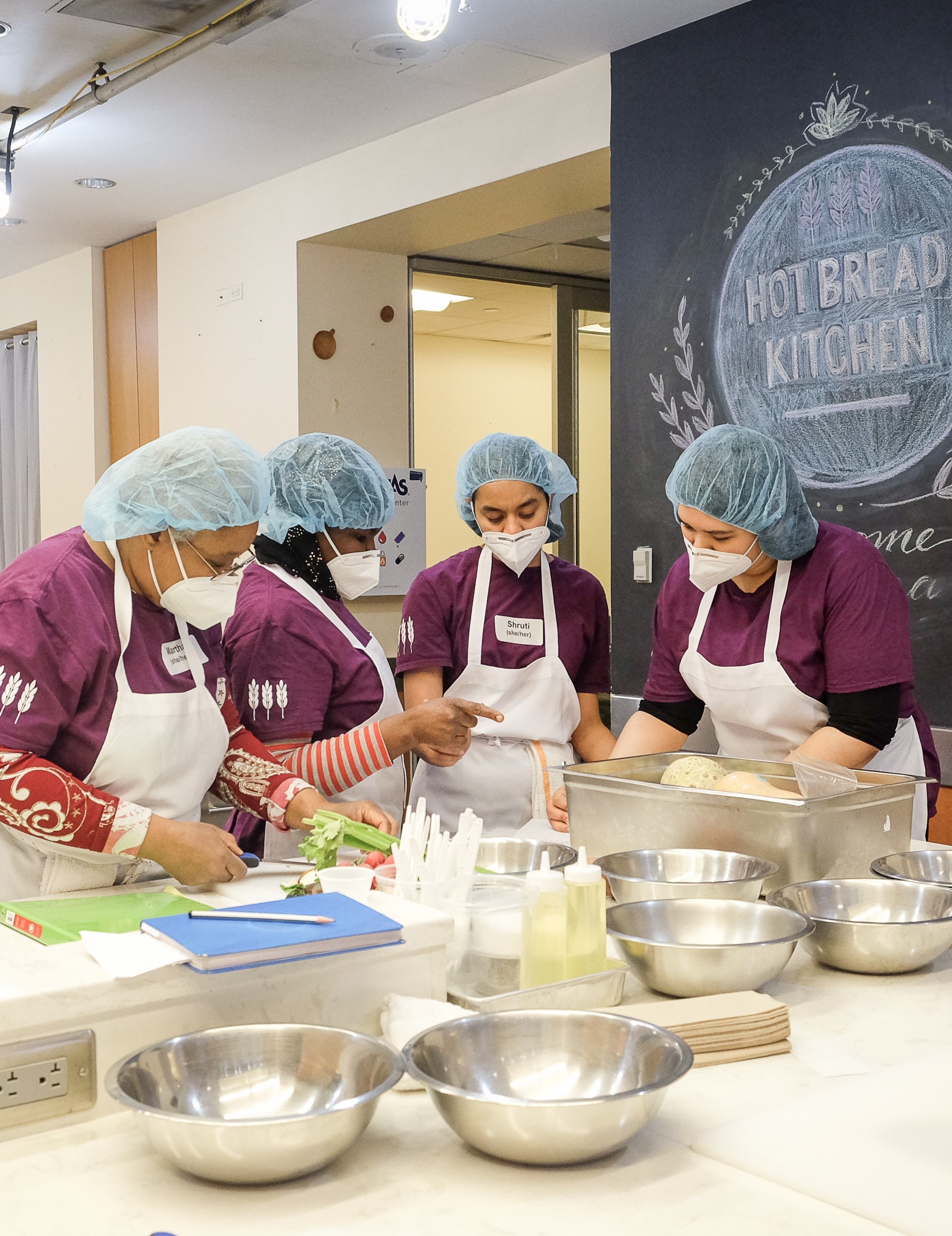-
The following is the executive summary for A City of Immigrants.
-
Read the full report (PDF).
New York City is a city of immigrants. New York is home to the most diverse immigrant population of any major city in the world and immigrants make up nearly half of the city’s workforce. Yet the city is faced with a paradox: while immigrants are employed at higher rates than native-born New Yorkers, they are disproportionately clustered in low-wage occupations and are frequently taken advantage of by both exploitative employers and predatory employment agencies. As the city government has begun restructuring its workforce development system, it has created an important opportunity to address these inequities faced by immigrant New Yorkers.
The study was made possible through the generous support of the Ford Foundation and the New York Foundation.
General operating support for the Center for an Urban Future has been provided by the Bernard F. and Alva B. Gimbel Foundation, the Lucius N. Littauer Foundation and the M&T Charitable Foundation.
Commendably, New York City Mayor Bill de Blasio is leading a shift in the city’s approach to workforce development by moving away from a system that prioritized rapid job attachment regardless of job quality and working instead to create a more equitable career pathways framework—a systemwide framework that aligns and coordinates education, training, credential attainment, and early job exposure opportunities to serve workers at various stages of the job continuum. In November 2014, the Jobs for New Yorkers Task Force, convened by Mayor de Blasio, issued the Career Pathways report, recommending a sector-based strategy to build skills among workers based on employer needs, improve access to quality jobs, and feature greater system and policy coordination.
This report argues that to succeed in this transformation, the de Blasio Administration and the philanthropic community must fully account for the needs of New York’s immigrant workforce and incorporate a population-focused strategy to complement its sector-based approach. Specifically, the workforce development system should build the right career ladders while raising workplace standards and job quality for immigrant workers, and improve immigrant access to workforce development services through enhanced systems coordination.
At stake in this shift is not only the economic empowerment of immigrant New Yorkers, but also the economic vitality of the city as a whole. Immigrants already contribute significantly to the city’s economy. These contributions could be even greater if immigrants were ensured access to workforce development services that meet their needs. A coordinated strategy for immigrant inclusion is critical
for the long-term success of public and private investments in workforce development and local poverty-fighting efforts, and the overall continued economic growth of our city.
A City of Immigrant Workers
At almost 40 percent of New York City’s population and nearly half its total workforce, immigrants are undeniably integral to the city’s economy. Immigrants bring diverse skills and multilingual assets
to the workforce. They also make up significant percentages of key sectors where the city is investing tremendous resources to build industry partnerships and career pathways, including food service, construction, healthcare and retail. Yet at the same time, too many immigrant workers are trapped in lower-wage occupations within these sectors and lack opportunity or access to tools for advancement.
An inclusive approach to workforce development should address all of the most common barriers to immigrants’ ability to advance along a career pathway and fully contribute to the local economy.
These include:
-
Significant rates of limited English proficiency among immigrant workers across all levels of formal education, skills, and work experience
-
Lower levels of formal education compared to the native-born population
-
Difficulty transferring or translating credentials in the United States for immigrants with higher education or professional experience from abroad, resulting in under-employment or “brain waste”
-
Vulnerability to workplace exploitation related to immigration status
-
Limited knowledge around navigating the US job market and adult education system and lack of familiarity with American workplace norms
-
Lack of access to, or awareness of, available workforce, adult education, and social support services, resulting in vulnerability to predatory employment agencies
A workforce development system that can help immigrants address these barriers would allow the city to fully benefit from immigrants’ diverse skill sets and work experiences while making it possible
for immigrants to reach their full potential as workers and residents of New York City.
A Fractured Workforce Development Ecosystem
The lack of coordination and of an immigrant-specific approach at the city level makes it difficult for immigrant New Yorkers to access the workforce development system. In addition, publicly funded workforce programs have not tracked or evaluated how immigrants in particular are being served by the current system. In interviews for this report, immigrant providers stated that publicly funded workforce programs tend to be poorly suited for immigrant needs, and are often nonexistent in the most immigrant-dense neighborhoods. In addition, undocumented immigrants are often ineligible to receive services from publicly funded programs due to federal funding restrictions. And while privately funded efforts have had success in reaching immigrant populations, they have generally done so only at a small scale. Community-based organizations that do serve undocumented immigrants rarely specialize in workforce development, and are faced with limited resources.
More coordination among and between public and private actors, both from within and outside of the city’s formal workforce development system, is needed to improve the system for all users, but
particularly for immigrant workers who have specific needs.
Recommendations
To be effective in a city where half of the workforce is foreign-born, New York City’s workforce development system must leverage sector-based and population-based strategies to ensure that immigrant workers and job-seekers can take advantage of workforce development services and thus participate more fully in the labor force. This will also ensure the overall success of the Career Pathways plan, given the sheer number of immigrants in the sectors it prioritizes.
New York City and the philanthropic community must address barriers to immigrant inclusion and the fractured workforce development ecosystem by adopting the following recommendations:
-
Build the right career ladders for immigrants. Meet the unique educational and training needs of immigrant New Yorkers within a sector-based framework by:
-
a. Making additional investments in ESOL and adult basic education that emphasize quality experiences and measurable positive outcomes in terms of educational and skills gains
-
b. Building bridge programs—defined by the city as programs that prepare individuals with low educational attainment and limited skills for entry into a higher education level, occupational skills training, or career-track jobs4—and training opportunities for LEP immigrants, particularly in key sectors where the city is creating industry partnerships
-
c. Reducing “brain waste” among high-skill immigrants through soft skills training, referrals to accreditation services, and investments in networking and mentoring programs
-
d. Connecting immigrants to social services and other wraparound supports that will enable them to actively pursue education and training
-
Improve immigrant access to workforce development through systems coordination by:
-
a) Filling service gaps in immigrant-dense neighborhoods, particularly where predatory employment agencies are most prevalent
-
b) Building robust linkages and referrals to incorporate smaller community-based organizations that specifically serve immigrants
-
c) Enhancing funding coordination to serve the full immigrant workforce, including undocumented workers
-
Raise workplace standards for immigrant workers. Protect workplace rights and improve job quality in low-wage occupations where vulnerable immigrants predominate by:
-
a) Supporting advocacy to hold employers accountable to labor law in partnership with the recently created New York City Office of Labor Standards Enforcement
-
b) Engaging with employers to improve job quality and connect immigrants to additional services, such as immigration legal services to help immigrant workers advance along a path to US citizenship
-
c) Developing the leadership skills and organizing power among workers




